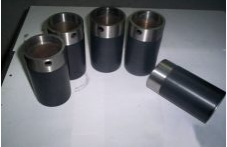

current position:Information and data>Thermal spray antistatic coating
In the textile industry, some parts that tighten the yarn need anti-static treatment to prevent the cotton yarn from catching fire due to static electricity. While transferring the cotton yarn, the textile parts contacted by the high-speed moving cotton yarn also need to have the ability to resist fiber abrasion.

Wear resistance, we thought of using chromium oxide and aluminum oxide powder to prepare superhard coatings, but the dielectric constants of these two coatings are between 9-10, and their electrical conductivity is not good even under high-voltage electric fields. High, natural anti-static ability does not meet the requirements.
Therefore, anti-static needs to be conductive. We have introduced conductive ceramic coatings in our previous public account articles: titanium oxide, aluminum oxide-titanium oxide coating (of course, there are also titanium oxide and zinc oxide that we are developing and testing). powder), especially the conductivity σ of the coating prepared by our titanium oxide powder can reach 1110-1250 μS/cm (the target field can be used with confidence). However, its hardness is not enough to resist fiber wear, so we provide customers with alumina-titanium oxide powder to prepare anti-static wear-resistant coatings.
When thermal spraying antistatic coating, in order to increase the bonding strength, nickel-based self-fluxing primer is usually used to prepare the transition layer first. It should be noted that the power of thermal spraying transition layer is often lower than that of preparing alumina-titanium oxide ceramics. The power of the surface layer; the spraying distance of the transition layer is also close to that of the alumina-titanium oxide ceramic coating; at the same time, in order to obtain a dense coating, a combination of argon + hydrogen can also be used to increase the enthalpy value, thereby allowing Ceramic powder with high melting point melts more thoroughly.
Mechanical polishing after thermal spraying determines whether the coating can achieve the desired mirror finish. Generally, silicon carbide grinding wheels are used for processing, and finally the holes are sealed with microcrystalline paraffin.
The article on this page is original, please inform us if you reprint it. If there is plagiarism, its shameful behavior will be cracked down.
Hot information

